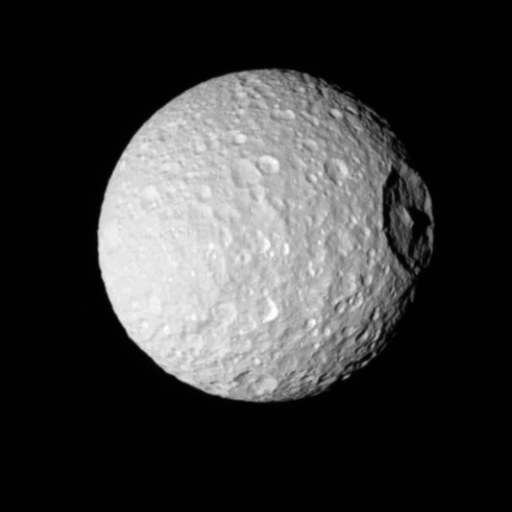
January 10, 2020
Large impact scenarios make no sense.
According to Electric Universe theory, the Solar System was chaotic a few thousand years ago. The scars left on its many moons and rocky planets are forensic evidence for that idea. How many thousands of years ago it happened is not important, since it is not millions of years or even hundreds of thousands of years that are under consideration. The premise is that electricity from highly active celestial objects discharged many times to the surfaces of most Solar System bodies.
Mimas is a tiny moon, with a radius of 198 kilometers. It is similar in size to Saturn’s moon Enceladus, so often discussed in these pages, and Proteus, one of Neptune’s moons. A giant hexagonal crater called Herschel dominates one hemisphere of Mimas. Whatever hit Mimas did not blow it apart, which is a mystery in astrophysical circles, since the crater is about 1/8 the moon’s diameter. Herschel crater was named for Sir William Herschel, who discovered Mimas in 1789. The crater is 130 kilometers wide, with a central peak as tall as Mount Everest. Such craters are theorized to form from asteroid impacts. However, there is little debris within the crater and not many boulders or other fragments around it.
It is thought that the lack of debris is because Mimas has little gravitational attraction, so the blast remnants did not fall nearby. It sounds plausible, except that craters on large planets like Mars—some many hundreds of kilometers wide—also demonstrate little fallback: their floors and sidewalls are swept clean.
According to NASA reports, a crater whose “…polygonal nature (meaning it resembles a shape made of straight lines) is noteworthy because most craters seen on other planetary bodies, including Earth, are nearly circular.” Although they were discussing the asteroid Ceres at the time, the point is meaningful.
34-kilometer-wide Haulani crater also possesses a smooth floor with a central ridge. The formation is anomalous, since impacts should create a conical formation from explosive force, along with a field of blast debris. Indeed, the number of crater anomalies found on rocky planets and moons seems to suggest that round craters are uncommon and the “anomalies” are common.
The greatest mystery of all is the shape of Haulani crater: it is a hexagon. NASA prefers to say that: “The straight edges of some Cerean craters, including Haulani, result from pre-existing stress patterns and faults beneath the surface.”
Previous Pictures of the Day point out that Jupiter and its moon Io exchange powerful electric discharges—more than 2 trillion watts! Perhaps electricity plays a larger role in planetary dynamics than modern physics can accept. Electric Universe physicists think that plasma discharges on moons create clouds of energetic particles that can influence other bodies. For example, Mimas has a “coating” of some compounds that were eroded from other moons in the Saturnian system, especially Phoebe. Perhaps the splotches of dark red and sooty black that color the faces of Rhea, Tethys, Iapetus, and Mimas are made of ultra fine dust electrically etched from Phoebe.
The electric currents that cut craters and rilles most likely left evidence in other ways. Since Mimas is connected to Saturn by “electromagnetic flux ropes”, that connection could have created the features on Mimas, as well as on other scarred worlds, when electrical activity throughout the Solar System was more powerful in the past.
Electrical activity in the form of lightning bolts, diffuse glow-mode clouds of energetic particles and rotating Birkeland currents could be the causative agents for bizarre conditions on celestial bodies. Ceres, for instance, appears as if it was caught in a titanic particle beam. Due to plasma instabilities in the discharge, a hexagon was cut deeply into its crust. When the electrical energy was withdrawn, the crater remained, a “fossilized” geometric shape permanently burned-in.
It is not beyond reason to suggest that star systems can experience catastrophic changes. Rapid increases in electricity from the galaxy could cause a star to increase its output by orders of magnitude, resulting in massive re-ordering of its charge balance. Some speculate that rocky bodies are expelled from stars and gas giants because of an electrical imbalance that appears to be a common phenomenon in the galaxy. Maybe some celestial bodies are not local to the Solar System, but arrived from great distances.
The Milky Way could be a wilderness of rocky bodies of every shape and size ejected from stars, especially brown dwarf stars, orbiting more powerful, more violent companions.
Stephen Smith
With apologies to George Lucas.
The Thunderbolts Picture of the Day is generously supported by the Mainwaring Archive Foundation.












